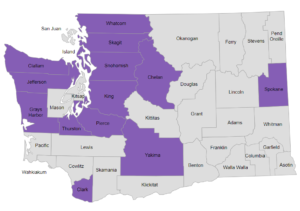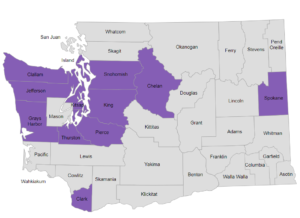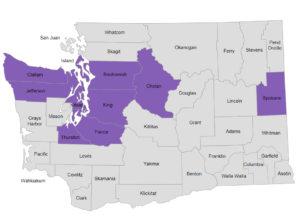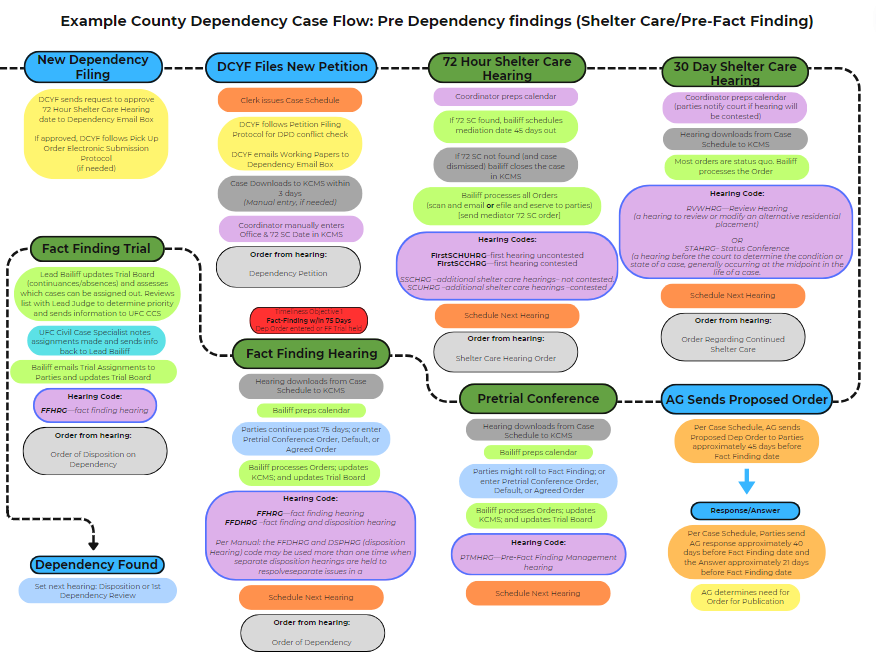Written in 2011 by Judge Patricia Clark1
Chapter Sections
Introduction
“Judges hold an ethical obligation to ensure effective administration of justice. They must require that their orders are carried out and that effective treatment will be provided” to the children and families they serve.”2
The goals of the Juvenile Court in dependency cases are multi-faceted. The court strives to protect children, provide due process to parents, monitor the actions of the agency, provide permanency for children, ensure that parents have a fair opportunity to reunify with their child, ensure child well being, and to permit everyone to be heard. All of these goals must be accomplished within prescribed timelines. This article will discuss the role of judicial leadership in a court that deals effectively with child welfare cases.
§1 Statutory Mandates
§1a Federal Law
The Adoption Assistance and Child Welfare Act of 1980 (Public Law 96-272) changed the child welfare system in the United States. The law made juvenile court judges and their findings essential in order for child welfare agencies to receive federal monies. PL 96-272 forced the court and child welfare agencies into what Judge Leonard Edwards aptly terms a “shotgun wedding.”3 The legislation requires the court to make “reasonable efforts findings” at critical points in the life of the case. The legislation also requires the following:
- The State must provide services to prevent children’s removal from their home in order to be eligible for federal foster care funds;
- In order to qualify for those federal monies the juvenile court must make ”reasonable efforts” findings that the state has in fact provided services to enable children to remain safely at home before they are placed in foster care;
- The juvenile court must also determine whether the State has made “reasonable efforts” to reunite foster children with their biological parents;
- The juvenile court must determine that there is a case plan developed to ensure placement in “the least restrictive (most family like) setting available and in close proximity to the parents’ home, consistent with the best interest and special needs of the child;”4 and
- The juvenile court must ensure that the status of every foster child is regularly reviewed and that a child is given a timely permanent placement, preferably in an adoptive setting, if return to the biological parents is not possible.
Neither the agencies nor the courts actively sought this relationship. From the courts’ perspective, they were given the responsibility of oversight but without any additional funding to absorb the impact.
To compound the problem faced by courts, the Adoption and Safe Families Act (Public Law 105-89) was signed into law in 1997 and set specific timelines for each stage of the case in an effort to move children more quickly out of foster care and into “permanent placements.” Again legislators looked to the courts to ensure that those timelines were being met by the agency. Both sides continue to struggle with the terms of this marriage. Although the courts have made considerable strides over the past 28 years in developing “best practices” (we in fact have a good sense of what works and what does not work), the courts have not uniformly accepted or implemented these practices.
To further develop a system which effectively implements “best practices” in your own court, consider the range of roles which a Juvenile Court Judge should play, as expressed by Judge Edwards:
Juvenile and family court judges can be leaders in their communities, state capitals, and at the national level to improve the administration of justice for children and families. Judges can be active in the development of policies laws, rules and standards by which the courts and their allied agencies and systems function….The very nature of the office mandates that the judge act as advocate and convener to assure that needed services for children and families are available and accessible.5
§1b State Law
In the state of Washington, the Basic Juvenile Court Act, RCW 1§3.04, gives the Juvenile Court exclusive original jurisdiction over all proceedings
- Related to children alleged or found to be dependent as provided in RCW 26.44 and 1§3.34.030 through 1§3.34.170;
- Relating to the termination of a parent and child relationship as provided in RCW 1§3.34.180 through 1§3.34.210; and
- To approve or disapprove out of home placement as provided in RCW 1§3.32A.170.6
Case law affirms this: “[M]atters of dependency should be handled exclusively and originally by the juvenile court.”7
The legislature sets out the judicial oversight role throughout RCW 1§3.34. The court is charged with overseeing the actions of the Department of Social and Health Services (DSHS) to ensure that two primary concerns are addressed: first, that DSHS’s actions are in the best interest of the child, and second, that the parents have the opportunity to cure their deficiencies and reunify with their children.
Much of that oversight is conducted through the requirement that the court make findings at critical stages of the case that the agency has made “reasonable efforts” across the spectrum of its dealings with the family. This includes efforts to prevent removal, efforts to provide the parents with notice, and efforts to provide the parents with remedial services.
The effective judge must also be prepared to hold all participants accountable for fulfilling their roles in the court process and the delivery of services.8 “[D]ependency proceedings are designed to protect children, to help parents alleviate problems, and, where appropriate, to reunite families.”9
Once dependency is established, RCW 1§3.34.130 gives the court the authority to order a variety of things to ensure this occurs including services to prevent removal, services designed to alleviate the reasons for removal, placement with the agency or relatives, and sibling visits. The same oversight responsibilities are replicated in the RCWs dealing with termination of parental rights.
§2 Leadership and Collaboration
The child welfare system, much like the families it serves, is a complex constellation of stakeholders, including but not limited to, mental health treatment providers, drug alcohol treatment providers, mandatory reporters, schools, law enforcement, hospitals, social workers, government (local, state, and federal), family members, and tribes. The judiciary is uniquely positioned to observe the operation of each of the stakeholders and to observe the interaction between them. That position allows the judge to identify resource needs across systems, to identify gaps in the service delivery system, and to monitor the efficiencies and inefficiencies in the system. Effective judges identify the issue or problem, convene the stakeholders, and use that convening to educate and then to motivate the system’s stakeholders to resolve the identified issues.
Much of what an effective juvenile court judge needs to accomplish requires collaboration across a broad spectrum of stakeholders, each with their own needs and agendas. “In assembling any collaborative to improve the administration of justice, it is imperative to ensure balance of representation….”10 All parts of the system must be represented and their opinions heard and taken into consideration.
Unlike with their typical role in the courtroom, a judge who is effective at leading a collaborative court will often develop a wide range of skills beyond the norm. (For example, the judge must lead without dominating the decision making process.) A judge in an effective collaboration is skillful at allowing decisions to be made by the group rather than coming as a result of the court’s normal role of “ordering” actions and outcomes. The judge must become adept at leading from the “back of the train.” Moreover, as these skills are developed, the group will look to the judge to make sure that all participants are heard and their opinions valued. In addition the judge will need to periodically refocus the group to prevent some from wandering away from the issues at hand.11
With all of this in mind, the judge must also avoid becoming aligned with one faction or another in the group. Collaboration in all of its permutations is a critical part of the juvenile court judge’s skill set. But it is worth noting once again that this skill set is not reflected in the traditional judicial role. It must be developed and nurtured in those who wish to successfully address the myriad issues facing juvenile and family courts.
§3 Case Management
The court must demonstrate an unmistakably strong commitment to timely decisions in child abuse and neglect cases. It must communicate to its own employees, the attorneys practicing before it, and the child welfare agency that timely decisions are a top priority. It must conduct and participate in educational programs concerning the elimination of delays. The court also must make necessary organizational adjustments related to delays, in cooperation with court and agency staff. The court must design explicit processes to ensure timely hearings and must make sure they are implemented by all judges and administrative staff.12
In order to create and operate an effective child welfare court system, the judge must collaborate across the totality of the systems involved in the court. The judge must facilitate the development of case management systems and methods for monitoring the performance of that system. To fulfill all
the tasks that have been given to the court, Juvenile Court Judges require education on a wide range of issues affecting children and families. In addition, the judge needs to understand collaboration, the dynamics of organizational change, lobbying legislative bodies, and communicating with the media and the wider public.
The only institution that can reasonably exercise leadership on behalf of the society and the children is the juvenile court The reason is simply that no other institution can claim to have an equally broad view of all the interests at stake, to have as wide a range of action, or to be able to make decisions that are designed to reflect the values of society as expressed in its laws and constitution.13
Download this chapter: Chapter 3 Judicial Leadership in Dependency Cases.pdf
ENDNOTES
- In 1987, the Honorable Judge Patricia Clark obtained a Juris Doctor degree and a Masters in Public Administration from the University of Washington. Before being appointed to the bench, she worked as a prosecutor, an educator, and a constitutional commissioner where she focused on at-risk youth. She was elected to the bench in 1998, and during her tenure used the power and the possibility of the judicial system to improve the lives of children, adolescents, and their families. Judge Clark served as the chief judge for the Juvenile Division of the King County Superior Court from November of 2002 to her retirement in 2013. She chaired the Juvenile Disproportionality Committee and the Dependency Disproportionality Committee, and was foremost in the implementation of Reclaiming Futures Treatment Court, Family Treatment Court, and Systems Integration. She also served as a member of Superior Court Judges’ Association and Superior Court Judges’ Association Family Juvenile Law Committee, and was also involved in developing the Operational Master Plan for Juvenile Court in the 21st Century. Judge Clark was a strong supporter of prevention programs that help keep young people out of the detention and foster care systems. She was honored with a 2003 Vanguard Award from the King County Washington Women Lawyers, a 2005 Voices for Children Award from the Washington State Children’s Alliance.
- Robert Wood Johnson Found., Reclaiming Futures: A Model for Judicial Leadership 4 (2006) [hereinafter Reclaiming Futures].
- Judge Leonard Edwards, ret., Address at the 2008 Oregon Child Advocacy Project Conference: Putting the Puzzle Together (Apr. 5, 2008), http://www.law.uoregon.edu/org/child/2008conference.php).
- 42 U.S.C. § 675(5)(A) (1980).
- Nat’l Council of Juvenile and Family Court Judges, Resource Guidelines: Improving Court Practice in Child Abuse & Neglect Cases 18 (1995), available at http://www.ncjfcj.org/content/blogcategory/369/438/ [hereinafter Resource Guidelines].
- RCW 1§3.04.030.
- Perry v. Perry, 31 Wn. App. 604, 608, 644 P.2d 142 (1982).
- See Resource Guidelines at 19.
- In re K.R., 75 Wn. App. 781, 791, 880 P.2d 88 (1994).
- Reclaiming Futures at 8.
- See Reclaiming Futures.
- Resource Guidelines at 20.
- Mark Harrison Moore, From Children to Citizens: The Mandate for Juvenile Justice 176 (1987).
